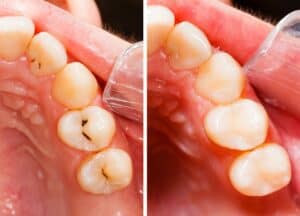A dental filling is the placement of materials such as porcelain inlays/Onlays or composites on a damaged or decayed tooth to restore the original shape and function. This can be a dental filling or only. While a dental filling fills the center of the tooth, it only is more comprehensive than a filling and can cover the entire biting surface of the tooth. Fillers are mainly used to prevent the spread of caries to the tooth and to protect dental health when caries are seen in the tooth. The decayed area in the tooth is cleaned, bacteria are removed, and the caries is prevented by closing the site.
Dental Filling Procedure
After the examination and x-rays, your dentist decides and creates an appointment for filling procedures. Many filling treatments take between 30 minutes and 1 hour, although the size of the tooth that needs filling, the depth of caries, and the position of the tooth in the mouth vary.
Local anesthesia is used during dental filling procedures. Many dentists ensure that the pain of the needle is not felt by applying a numbing spray or gel on the area to be injected before the local anesthesia injection. This is a procedure that prevents tension and is more comfortable for patients.
When the area to be treated is completely numb, the dentist cleans the cavities with the help of a tiny drill and closes the gaps with filling. Dentists will also perform bite checks to ensure proper bite function is maintained. Small teeth filing operations can be achieved for natural biting to be performed as before.

After the Dental Filling Procedure
After the treatment is completed, the numbed area continues to feel numb for about 2 hours. For this reason, it is not recommended to chew with this side of your mouth before the numbness is completely gone. Since filling treatments are straightforward procedures, there is no problem afterward, but when discomfort is felt, it is necessary to consult the dentist.
Porcelain Fillers
The fillings are made with a moan, and only the material has the same color as the tooth. These fillings, also known as white fillings, among the people are compatible with the existing dental aesthetics. Porcelain fillings are indistinguishable from other teeth and can last up to approximately 20 years.
Composite Fillings
Composite fillings are similar to porcelain fillings but less durable than porcelain fillings. Composite fillings can last for approximately five years or ten years. Then, they must be replaced.
Gold Fillings
Before the gold fillings can be adjusted to fit the tooth cavity, the mold must be taken, and gold fillings must be formed and glued in the laboratory. Gold fillings, the most expensive type of dental filling, require a visit to the dentist for several sessions. This filling, accepted by the gingival tissue, provides durability for over 20 years.
Amalgam Fillings
The most widely used amalgam fillings are the least expensive type of dental filling. Because amalgam fillings contain mercury, their use has been completely stopped in some countries. Moreover, since such fillers expand and shrink at heart, they may cause cracks in the teeth after a while. For this reason, dentists can obtain help to replace amalgam fillings with porcelain and composite fillings.
Dental Filling Care
After the dental filling process is completed, the patient can return to everyday life in a short time. Food can be eaten as before, but waiting until the numbness in the mouth is completely gone is useful. As well as biting your cheek and tongue due to drowsiness and consuming something scorching may cause burns in the mouth. If your filling is a little deeper, it is normal to experience pain for a while. However, if the pain continues after one week, the patient should get in contact with the dentist.



